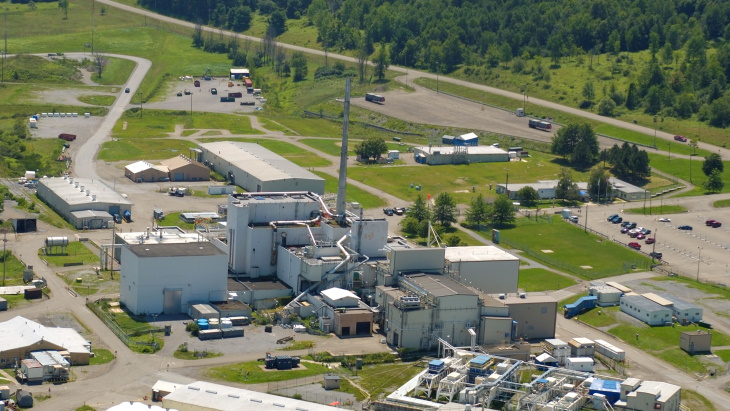West-Valley-aerial-view-(DOE-West-Valley-Project).jpg

Part 2 of 2 Parts (Please read Part 1 first)
It is possible to design new advanced nuclear reactors to burn recycled fuel. Recycling spent nuclear fuel depends on separating the energy-generating uranium and plutonium isotopes from all the other elements and compounds found in spent fuel while not producing pure plutonium which is a proliferation risk. In addition, the final product of the recycling process has to have a very precise ratio of uranium and plutonium isotopes in order to create new fuel that can be used in nuclear reactors.
The chemical slurry produced by grinding up and dissolving spent nuclear fuel pellets is fed into a centrifuge processing system. The solution flows through the system where mixing, centrifuging, adding or subtracting different chemical compounds takes place.
Lines said, “Real-time monitoring was pivotal to determining exact chemical elemental ratios. We really focused on the uranium-plutonium percentages and knew exactly what they were at any given point.” Real time monitoring improves efficiency and reduces costs. Lines said, “Ultimately, it empowers researchers and operators by providing nearly instantaneous information to help control and understand chemical processes.” The PNNL real-time monitoring capabilities have evolved exponentially over the past twenty-five years.
Separation researchers often depend on manmade, simulated nuclear fuel in order to mimic the processes under study because real spent nuclear fuel is costly to acquire and study. However, simulating nuclear fuel is also expensive, especially at the large, industrial scales that are necessary to study bulk recycling and separation processes.
In order to meet the challenge, the PNNL has developed complementary approaches that can be explored at a much less expensive and smaller scale. The PNNL researchers employ microfluidics or what is referred to as lab-on-a-chip. This technology coupled with real-time monitoring allows researchers to track chemical processes on a device that is the size of a microscope slide.
Lines said, “We can run the same types of separations studies and track the exact composition of uranium fuel components and fission products throughout the recycling processes, similar to what is done at a lab or industrial scale.”
The PNNL researchers are also able to obtain and make use of real spent nuclear fuel because the scale of their experiments is so much smaller. Lines said, “This technology is cost efficient and enables incredible opportunities to develop and advance recycling approaches.”
The PNNL has a long history of finding solutions to some of the nation’s toughest challenges in dealing with spent nuclear fuel. These solutions range from reducing the amount of radiation in high-level radioactive waste to developing a separation process to remove hazardous elements in spent fuel.
Gregg Lumetta said, “We've been advancing fuel-cycle operations for decades. This most recent work is a platform for us to expand upon as we continue to pursue chemical separations for advanced fuel-cycle options."
With plentiful deposits of uranium and new extraction processes that can remove uranium from seawater, only time will tell if recycling spent nuclear fuel can ever be a practical way to obtain fuel for nuclear reactors.